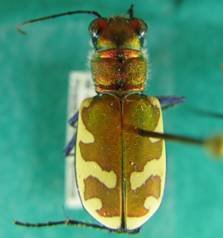Creating a digital menagerie
June 29, 2012
NEON technicians will collect and identify countless insect specimens over the lifetime of the observatory. To put it into perspective, during a short prototype collection at one site over three weeks using 20 traps, we collected close to 400 ground beetles. Now imagine 40 traps collecting insects at 60 sites for several months every year for 3 decades, not to mention the mosquito sampling that often produces several thousands of specimens from a single night of trapping! This volume of sampling will mean a tremendous amount of valuable data, but it also presents a significant challenge for maintaining accurate species IDs. How do you standardize species identifications across dozens of sites and over decades of monitoring?

We address this issue in a recent publication that provides both preliminary data and an introduction to NEON's approach to monitoring ground beetle and mosquito biodiversity, two groups NEON is targeting.
NEON is part of a growing effort to monitor biodiversity globally (GEOBON, SAEON, TERN, EBONE

DNA barcodes [[nid:6123]] DNA barcodes are unique, species-specific DNA sequences that come from the “powerhouses” that make energy inside most every animal, plant and fungal cell – making them easy to obtain and universal to a lot of Earth’s biodiversity. DNA barcodes will help NEON to standardize species identifications across time and space, but tying those molecules to a voucher specimen that has been reliably identified by an expert morphological taxonomist is crucial to making sure we are gathering the highest quality data possible.
The specimens that we are using to build this library come from collections made during NEON prototype field campaigns as well as from museum-archived specimens up to 80 years old! All of the sequence data, photos, and other information can be publicly accessed online from the Barcode of Life Data System (BOLD). Because it is publicly available, NEON’s reference library will also serve a variety of other possible uses for many other people. Ecologists will be able to gain insights into population changes over time and in response to differing land use types. Public health surveyors will be able to skip the time-intensive and costly steps of rearing juvenile mosquitoes through to adulthood for species IDs. Citizen scientists will be able to download region-specific species lists to learn about their local fauna and the critical ecosystem services they perform. All of this from uniting molecules with morphology!
*Many similar efforts are generating DNA barcodes for a variety of life forms to answer questions ranging from conservation issues to simply understanding what exists on our planet.
Here are some examples that have also been published in PLoS ONE recently:
- The Barcode of Life Data Portal: Bridging the Biodiversity Informatics Divide for DNA Barcoding
- Joining Inventory by Parataxonomists with DNA Barcoding of a Large Complex Tropical Conserved Wildland in Northwestern Costa Rica
- Barcoding a Quantified Food Web: Crypsis, Concepts, Ecology and Hypotheses
- Pyrosequencing for Mini-Barcoding of Fresh and Old Museum Specimens
- A DNA Barcode Library for North American Ephemeroptera: Progress and Prospects
- Wolbachia and DNA Barcoding Insects: Patterns, Potential, and Problems
